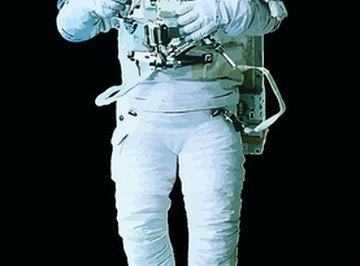
Because tools you would find at home-improvement or hardware stores aren't usable in the harsh environment and specialized work areas of space, the National Aeronautics and Space Administration (NASA) modified tools for astronauts. For example, astronauts must wear large, bulky pressurized gloves and it would take too much energy to close the fingers around a regular-sized tool handle. So all tools used by astronauts have extra large handles and all tools attach to retractable tethers so they do not fly away when dropped.
Safety Tethers
All astronauts must wear safety tethers when working out in space. Safety tethers, designed from heat-resistant webbing, attach to the astronaut's waist and extend 25 feet. The other end of the tether attaches to handrails in the space station's frame. If astronauts participate in spacewalks, the safety tether keeps them from floating away into space. Some tethers feature self-closing garbage bags for extra bolts and others act as toolbelts for the astronaut so no equipment or tools become lost in space.
Pistol-Grip Tool
NASA created its own version of a cordless drill called a pistol-grip tool, considered a staple tool for astronauts. The pistol-grip tool features a handle similar to a pistol and an information screen. The handle contains slots for rechargeable metal hydride batteries which holds a greater charge during the extreme temperatures of space. The screen displays torque and speed settings made by the astronaut.
The pistol-grip drill runs between 5 and 60 rotations per minute and the torque ranges from under one to 38 foot pounds of force. As of 2010, engineers prefer this modular pistol-grip tool, developed in 1993 and designed for added improvements.
Trace Gas Analyzer
While making repairs or working on construction in space, astronauts must make certain leaks of fluid do not occur or know when it happens in order to contain it. Trace gas analyzers, about 2 inches long, sit in a unit the size of a shoebox on the astronaut's chest. This analyzer detects leaking gas, water, oxygen, rocket fuel and more.
Robotic Arm
As of 2010, NASA uses a jointed construction crane partially funded by the Canadian government called Canadarm 2, designed to move objects weighing more than 200,000 pounds. This crane, guided by closed-circuit television, features force sensors giving it an sense of "touch."
Some of the uses the Canadarm 2 include checking for shuttle damage, lifting heavy equipment and attaching space station modules, such as the Italian-built node attached to the International Space Station in 2010.
References
About the Author
Chyrene Pendleton has been a business owner and newsletter editor for more than seven years. She is a freelance writer with over 25 years experience and teaches a variety of topics, including alternative health, hair care and metaphysics. Pendleton is a certified television show producer, radio talk-show host and producer, and a computer programmer with a bachelor's degree in computer science.
Photo Credits
cosmonaute image by photlook from Fotolia.com
